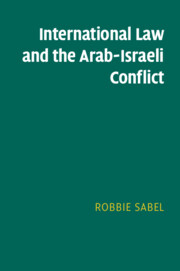Book contents
- International Law and the Arab-Israeli Conflict
- International Law and the Arab-Israeli Conflict
- Copyright page
- Contents
- Abbreviations
- Introduction
- 1 Is International Law Relevant?
- 2 The World War I
- 3 The Zionist Movement and the 1917 Balfour Declaration
- 4 Post–World War I and the 1922 League of Nations Mandate for Palestine, 1920–1947
- 5 The 1947 Partition Plan
- 6 Israel’s Declaration of Independence
- 7 The 1948 Arab-Israeli War
- 8 1949 Armistice Agreements
- 9 The Arab Refugee Problem
- 10 The 1967 Six Day War
- 11 UN Security Council Resolution 242
- 12 Camp David 1978
- 13 1979 Egypt–Israel Peace Treaty
- 14 Taba Arbitration
- 15 The Legality of Israeli Exploitation of Oil from Sinai
- 16 The Oslo Accords
- 17 Israel–Jordan
- 18 Post Oslo Developments
- 19 The Status of the ‘West Bank’ (Judea and Samaria) and the Gaza Strip
- 20 Israeli Settlements in the West Bank
- 21 Controversial Elements of Military Administration
- 22 Freedom of Navigation through International Waterways in the Region
- 23 Israel–Syria
- 24 Jerusalem
- 25 Controversial Laws of War Issues
- 26 Is Palestine a State?
- 27 Water Resources
- 28 Implications for Future Negotiations
- Index
27 - Water Resources
Israel and Neighbours
Published online by Cambridge University Press: 21 April 2022
- International Law and the Arab-Israeli Conflict
- International Law and the Arab-Israeli Conflict
- Copyright page
- Contents
- Abbreviations
- Introduction
- 1 Is International Law Relevant?
- 2 The World War I
- 3 The Zionist Movement and the 1917 Balfour Declaration
- 4 Post–World War I and the 1922 League of Nations Mandate for Palestine, 1920–1947
- 5 The 1947 Partition Plan
- 6 Israel’s Declaration of Independence
- 7 The 1948 Arab-Israeli War
- 8 1949 Armistice Agreements
- 9 The Arab Refugee Problem
- 10 The 1967 Six Day War
- 11 UN Security Council Resolution 242
- 12 Camp David 1978
- 13 1979 Egypt–Israel Peace Treaty
- 14 Taba Arbitration
- 15 The Legality of Israeli Exploitation of Oil from Sinai
- 16 The Oslo Accords
- 17 Israel–Jordan
- 18 Post Oslo Developments
- 19 The Status of the ‘West Bank’ (Judea and Samaria) and the Gaza Strip
- 20 Israeli Settlements in the West Bank
- 21 Controversial Elements of Military Administration
- 22 Freedom of Navigation through International Waterways in the Region
- 23 Israel–Syria
- 24 Jerusalem
- 25 Controversial Laws of War Issues
- 26 Is Palestine a State?
- 27 Water Resources
- 28 Implications for Future Negotiations
- Index
Summary
The location of water resources played a role in determining the post-World War I Palestine–Syrian border and presumably will play a part in future negotiations with Syria. Although Syria and Lebanon are upstream riparians on the Jordan basin, the two countries have alternative water resources and are therefore less dependent on the Jordan basin for their water supply. For Israel, Jordan and the Palestinians, however, the Jordan basin offers a primary source of water. The Johnston Plan served as a basis of understanding between Jordan and Israel but without explicit references to international law. The Israel–Jordan peace treaty and the bilateral interim arrangements reached between Israel and the Palestinians deal with allocations of specified quantities of water and not with legal principles. Future negotiations between Israel and the Palestinians will have to find a compromise between two basic tenets of international law, the rule of not causing appreciable harm to existing uses and the inherently contradictory rule of equitable allocations.
Keywords
- Type
- Chapter
- Information
- International Law and the Arab-Israeli Conflict , pp. 400 - 420Publisher: Cambridge University PressPrint publication year: 2022

